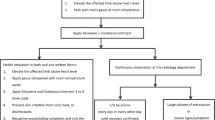Abstract.
Extravasation of contrast material is a well-recognized complication of contrast-enhanced imaging studies. The management of this complication is contentious; therefore, the Contrast Media Safety Committee of The European Society of Urogenital Radiology decided to review the literature and issue guidelines. A comprehensive literature search was carried out. The resulting report was discussed at the 8th European Symposium on Urogenital Radiology in Genoa, Italy. Automated power injection may result in extravasation of large volumes and may or can lead to severe tissue damage. Infants, young children and unconscious and debilitated patients are particularly at risk of extravasation during contrast media injection. Fortunately, most extravasations result in minimal swelling or erythema, with no long-term sequelae; however, severe skin necrosis and ulceration may occur. Large volumes of high osmolar contrast media are known to induce significant tissue damage. Compartment syndrome may be seen associated with extravasation of large volumes. Conservative management is often adequate, but in serious cases the advice of a plastic surgeon is recommended. Based on the review simple guidelines for prophylaxis and management of contrast medium extravasation injuries are proposed.
Similar content being viewed by others
Author information
Authors and Affiliations
Additional information
Electronic Publication
Rights and permissions
About this article
Cite this article
Bellin, MF., Jakobsen, J.Å., Tomassin, I. et al. Contrast medium extravasation injury: guidelines for prevention and management. Eur Radiol 12, 2807–2812 (2002). https://doi.org/10.1007/s00330-002-1630-9
Received:
Accepted:
Issue Date:
DOI: https://doi.org/10.1007/s00330-002-1630-9




